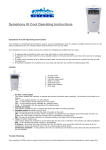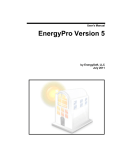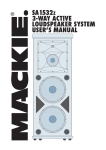Download 2. Entertainment and Communication
Transcript
Guidance for Activities in Dementia Care 2 – ENTERTAINMENT & COMMUNICATION 2 - ENTERTAINMENT & COMMUNICATION The person Activity: Name: Date: Is this activity beneficial to this person? Answer questions only if they are relevant. Mark with a tick for YES, cross for NO √X PERSON WITH DEMENTIA Character & personality Does the person like to be entertained? Are they generally communicative? Is the person happy in themselves? Will they try new things? Interests & activities Did they have special abilities (sing, dance or play an instrument)? Do they still have any of those skills or interests? Do they enjoy the latest fad or fashion? Do they have particular groups or entertainers they follow? Are they a fan of some sort (sports, pop stars, etc.)? Do they enjoy following a team or having a season ticket? Do they like parties, either attending them or throwing them? Do they like contests (singing, skating, etc.)? Do they follow soap operas on television? Groups Were they part of any regular groups in the past? Do they enjoy doing things in a group of people? Were they part of a faith community in the past? Are they still or would they like to be part of a faith community? Travel Do they enjoy going to shows or the theatre? Do they drive or have access to a car? Do they take public transport? Would they like to travel? Media Do they listen to the radio? Do they watch television? Do they talk on the phone? Would they like to do any of these things? Privacy, choice & control Can the person enjoy this activity in private? Are they able to choose who to enjoy it with? Can the person choose when and where to be involved? If the activity involves a specific device or technology: Does the person find it aesthetically pleasing? Do they like the colour & style? Copyright © 2007 The University of Sheffield Page 1 of 12 Guidance for Activities in Dementia Care 2 – ENTERTAINMENT & COMMUNICATION Do they like the shape and size? Does the person know they are allowed to use the device? Do they know they are allowed to use the electricity it requires? Do they know or feel they are allowed to spend the time? Will there be choices the person can make if they wish? Will the person be able to choose or decline the specific technology? Does the technology involve making choices (e.g. selecting songs)? If so, is the person capable of expressing their likes and dislikes? Is someone available to help them make decisions? If necessary, is there someone who knows the person well enough to choose for them? Can the technology be personalised? Will the person play a part in that? Will the person recognise their name or picture? Psychological & emotional Are they free from stress or anxiety? Are they not suffering from depression? Are they free from boredom? Physical & medical Accessibility & mobility Is the person able to stay awake, aware and engaged? Is the person physically comfortable? Are they warm enough and free from draughts? Is the person's prescription medicine at appropriate levels? Is the person free from pain? If the activity involves a specific device or technology: Does the person have: Dexterity required operating it? Grip strength or physical body strength required to operate it? Fine motor skill (turning motion, precision) required to operate it? Use of hands and fingers required to operate it? Touch sensitivity required to operate it? If not is support for physical disability available if needed? Sensory Sight Can they make out facial expressions across a daylit room? Can they make out facial features of a person sitting nearby? Can they see normal signage such as names/numbers on doors? Can they read printed materials such as a book they are holding? If not can large print or audio versions be provided for them? If they require glasses can these be provided? If they use glasses, are these on and clean? Is the person’s sight adequate to see how to operate the device or equipment associated with this activity? Hearing Can they hear normal levels of conversation across a room? Copyright © 2007 The University of Sheffield Page 2 of 12 Guidance for Activities in Dementia Care 2 – ENTERTAINMENT & COMMUNICATION Is their hearing adequate to hear another person within arm's length? Is their hearing tested regularly? If they require support for hearing impairment can it be provided? If they use a hearing aid, is it clean and properly adjusted? Do they use sign language or read lips? If so, can they be seated where they can see lips and faces clearly? Is the person’s hearing adequate for using the device or equipment associated with this activity? Cognitive & intuitive Do they like to ask questions? Do they enjoy learning new things? Do they find devices and gadgets interesting? Are they inquisitive about gadgets or equipment? Could they turn a device on and use it without prompting? How well supported is the person by other people? Answer questions only if they are relevant. Mark with a tick for YES, cross for NO CARE, SUPPORT & CULTURE Caregivers Does the person regularly make decisions about entertainment? Is the person being shown how to use entertainment devices? Is there someone who facilitates the person's use of technology? Is someone helping the person choose what to watch or listen to? Is the person able to go on the internet and 'surf the web'? Can somebody provide physical support to the person if necessary? Can the caregiver choose when the entertainment occurs? Can the caregiver control where the entertainment occurs? Can the caregiver choose who else is involved? Are grants available to purchase the device? If not, is there someone willing to purchase the device? Does the caregiver feel the device is good value for money? Would somebody buy the person a music CD or similar item? If the activity involves a specific device or technology: Can a caregiver plug in, turn on and use the device? Does someone know how to maintain and adjust the device? Can they give clear, simple instructions to the person? Can they not rush but take it at a pace comfortable for the person? Do they have the time to routinely assist the person to use the device? Can they establish a routine time for use of the device? Can they establish a routine place for use of the device? Are they aware of a time when the person could most benefit? Is there a time that fits into the routines of daily life? Can use of the device occur spontaneously? Is there a person or company to call if the device is not working? Does the caregiver know how to 'troubleshoot' common problems? If the device involves transmission of images and /or sound: Can the person or their caregiver control who sees the incoming Copyright © 2007 The University of Sheffield Page 3 of 12 Guidance for Activities in Dementia Care 2 – ENTERTAINMENT & COMMUNICATION images? Can the person or their caregiver control who sees the outgoing images? Friends & family Does the person have any friends or family living nearby? Do friends or family visit? Does the person share any particular interests with any of them? Does the person receive phone calls? Does the person receive or exchange email? Do grandchildren play a role in their life? Peer group Is the entertainment appreciated by the person's peers? Is the entertainment age-appropriate & respectful? Community Do volunteers participate socially in their life? Does the person have any links to local community groups? Are there young people in their life? Does the technology encourage political education or engagement? Does it encourage or assist a person to vote? Does it raise their awareness of political issues? Does it provide opportunities to develop opinions on local issues? Does it facilitate or enable involvement in volunteering? Does it encourage social inclusion (involvement in mainstream life)? Does it facilitate contact with community organisations or groups? Does it enable involvement with children such as foster grandparenting? Culture Is the type of entertainment something the person recognises? Are the images or sounds familiar to the person? Is the entertainment something meaningful to the person? Does it reinforce or express their beliefs, values or aspirations? Does the device operate in a way that is familiar to the person? Does the entertainment reinforce the person's customs or traditions? Care home Is entertainment written into the person's care plan? Does it contain details about the person's musical preferences? Does the care plan include access to assistive technology for enjoyment? Can people choose the music to listen to during meal times? Can the caregiver and the person enjoy entertainment in private? Is the caregiver able to provide (if needed) drinks, food, chairs, etc? Total potential person barriers to entertainment and communication Copyright © 2007 The University of Sheffield Page 4 of 12 Guidance for Activities in Dementia Care 2 – ENTERTAINMENT & COMMUNICATION 2 - ENTERTAINMENT & COMMUNICATION 2.1 One or two people using entertainment media – e.g. radio, music player The place Does the place support this activity? Answer questions only if they are relevant. Mark with a tick for YES, cross for NO √X SPACE PROVISION Is there a space in which a person can become amused, diverted and distracted? Does the space enable a person to pursue what interests and pleases them? Is there a permanent location for the entertainment device so it can be used at any time (or is it put away or out of sight)? Is there adequate space to position the device among the person's own possessions? Is there a room in which the person can keep and use the device other than their bedroom? Is there storage for materials or supplies related to the entertainment device? PERSONALISATION & PRIVACY Do the person or their friends & family have some control over light, noise and distractions entering the space? Do the person or their friends & family have some control over the location & direction of seating? Does the space offer satisfying stimulation of the person's own choosing? Is there a view to outdoors to relax the eyes or daydream? Is it a relaxing and pleasant space with comfortable seating and interesting stimulation? Can the door be closed by the person or family & friends for privacy? Is a personal conversation possible in the space? Is this the individual's personal space, full of their things? Can they personalise the space? Does the entertainment offer the person choices? Can materials be left out and not disturbed by others? If it belongs to the person, is it located among their belongings in their own space? ACCESSIBILITY & MOBILITY Is there unimpeded access into and out of the space? Is the space easy for them to reach, not far out of their way? Is there enough space in the room to manoeuvre mobility devices? Is there a level surface available for the device to the side of where the person usually sits? Is there enough space on this level surface for the device without moving items? Can the person reach the device without leaning uncomfortably forward or sideways? Is the seat also within reach of a level surface for a drink or personal items? Is the level surface for the device at least the same height as the Copyright © 2007 The University of Sheffield Page 5 of 12 Guidance for Activities in Dementia Care 2 – ENTERTAINMENT & COMMUNICATION chair seat? Is the person's chair within arm's reach of where the device can be placed? for two people: Are there two chairs close together, at least one within arm's reach of the device? Are the chair and the level surface close enough together for the person to operate the device comfortably? COGNITIVE SUPPORT Does the space focus and hold a person's attention? Does the space offer satisfying stimulation of the person's own choosing? Is the device visible from where the person normally sits? Is the device visible from more than one seat in the room? If the device has a visual prompt can it be seen and read by the person? BUILDING INTERIOR Fixtures Are there shelves/cabinets in the room to put equipment on? Furniture Will it be possible to use the device without rearranging the furniture? Chairs Do chairs give good comfort & support? Do chairs have arm rests? If the person has difficulty arising, do arm rests project in front of the seat? If the person needs it, do chairs have back rests with lumbar support? If the person would benefit, do chairs have head support? Is the seat a comfortable height from the floor for the person? Are chair seats warm to the touch and not too deep for the person? If the person would benefit, is there a clear kick space back from the front of the seat? If the device has a projected image are all seats out of the line of projection? Supplies Is there necessary equipment and materials (technology, DVDs, CDs, etc.)? Storage Is there storage for materials or supplies related to the entertainment device? COMFORT, SUPPORT FOR THE SENSES For the following questions you will already have a device or for of entertainment in mind or perhaps be already using one, and have a room or space in mind where it will be or is being used. Answer these questions keeping in mind the device, the space and the person/people using it Vision Is the entertainment equipment well-lit day or evening so the person or their caregiver can see to operate it? Is there ample light at any time for someone to read device Copyright © 2007 The University of Sheffield Page 6 of 12 Guidance for Activities in Dementia Care 2 – ENTERTAINMENT & COMMUNICATION instructions, programme listings, etc.? Can the lighting be controlled - the brightness, direction of light and when it comes on? Glare is bright uncomfortable light reaching the eyes, usually from sun reflecting off Glare a shiny surface or from looking directly at a light bulb. Is there a lack of bright light coming through the window into the person's eyes during entertainment? Are light bulbs shaded from view so the person cannot see them directly? Are clear glass light fixtures avoided? Is there task lighting in the room near the device? Does task lighting come from overhead and one side rather than from in front of the person? Acoustics Sound quality Is the entertainment or device loud enough for the room? Background noise Does traffic or other external noise not interfere? Is there good sound insulation between rooms? If needed, can the door to the room be closed to reduce noise from the corridor? Acoustic Would normal use of the device not disturb others in adjacent rooms isolation or houses? Is the presence of nearby activities or people in adjacent rooms not a loud, annoying, regular disturbance? Sound absorption Is there carpeting? Are there curtains, cushions, wall coverings or upholstery? If needed, are there acoustical baffles or sound absorbers such as wall hangings, banners or tapestries? Heating & ventilation Is the air in the room fresh and not overly stuffy? Is there noticeable air flow but not a draught? SERVICES & SYSTEMS Electrics Are there adequate electric outlets for use of the device/equipment? Is an electric outlet near where the person normally sits? Phone, cable, & IT Systems Is there a phone line, TV cable and power outlet all in one location? Is there a phone line in the home? Is there a phone line in their sitting room? Is there a phone line in their bedroom? Is there a broadband internet connection? Is there a loop induction system if the person needs or can benefit from it? Copyright © 2007 The University of Sheffield Page 7 of 12 Guidance for Activities in Dementia Care 2 – ENTERTAINMENT & COMMUNICATION If you are using a speaker system: If there are external speakers are they placed above the listener’s ear level? If speakers are in front, are they equi-distant on either side of the screen? If surround sound speakers, are they placed alongside and slightly to the rear of the seats? EQUIPMENT OR DEVICE Space Is there adequate space for the person to stand near the device if it provision is wall-mounted? Is there nearby & accessible storage of media such as CDs or videos? Personalisation If it belongs to the person, is it located among their belongings in their own space? Are there written instructions with the device for the caregiver? Is there a user's manual? Are there simple instructions of what to do if it stops working properly (troubleshooting guide)? Is there an agreement in place for maintenance, upgrade & repair? Is it possible to use the device in more than one room or outside? Cognitive support Can the device have the person's name prominently displayed so they can identify it? Will a wall-mounted device be seen from the person's seat? Is the device visible to a person as they enter the room? Fixtures If the device is to be wall-mounted: Is there space available on the wall? Will the mounting be secure and sturdy enough? Safety & security Can no part of the device be removed and accidentally eaten? If needed, can the device be secured against removal from the room? If needed, can the device be secured against removal from the building? Can the device be dropped or used heavily without breaking? Can the device be fixed so as not to drop or break during heavy use? Total potential place barriers to one or two people using entertainment media – e.g. radio, music player Copyright © 2007 The University of Sheffield Page 8 of 12 Guidance for Activities in Dementia Care 2 – ENTERTAINMENT & COMMUNICATION 2 - ENTERTAINMENT & COMMUNICATION 2.2 One or two people using a computer screen to communicate The place Does the place support this activity? Answer questions only if they are relevant. Mark with a tick for YES, cross for NO √X SPACE PROVISION Is there a space in which a person can become amused, diverted and distracted? Does the space enable a person to pursue what interests and pleases them? Is there a permanent location for the screen so it can be used at any time? Is there adequate space to position the device among the person's own possessions? Is there a room in which the person can keep and use the device other than their bedroom? Is there a room for using the device other than (or in addition to) a bedroom? Is there a small communal room for a group of 3-4 people to sit and use the device? Is there a room for a group of 5 or more people to sit and use the device? Is there a place in the room to use this without rearranging furniture? Is there enough room on a level surface to place the monitor/screen without moving other items? Is there space to move two chairs to in front of the monitor screen without obstructing the room? Is there an unobstructed sight line to the monitor screen from one or more seats? Without moving furniture, is the view straight ahead and not looking uncomfortably sideways or up? PERSONALISATION & PRIVACY Is it a relaxing and pleasant space? Is there comfortable seating? Can the door be closed by the person or family & friends for privacy? Is a personal conversation possible in the space? Is this the individual's personal space, full of their things? Can they personalise the space? Can materials be left out and not disturbed by others? If the screen belongs to the person, is it located among their belongings in their own space? Is the screen positioned so only the person or their caregiver can see and hear it? Does the outgoing view capture and transmit a neutral, non-intrusive area of the home? Is the screen positioned so it is not visible to a bystander outside through the window? Are the webcams positioned to prevent visual intrusion into the person's living space? Copyright © 2007 The University of Sheffield Page 9 of 12 Guidance for Activities in Dementia Care 2 – ENTERTAINMENT & COMMUNICATION Does the placement of the monitor or screen in the room prevent it from having to compete with the television? ACCESSIBILITY & MOBILITY Is there unimpeded access into and out of the space? Is the space easy for them to reach, not far out of their way? Is there enough space in the room to manoeuvre mobility devices? Can a person in a wheelchair use the computer? Are chairs at a comfortable height to view the monitor screen? Is the top of the screen at eye-level height for people seated? If it is a touch screen, is the screen close enough for the person to touch it? Is there an accessible space with a chair (or two) at a counter, table or desk? COGNITIVE SUPPORT Is the device visible from where the person normally sits? Is the device visible from more than one seat in the room? If the device has a visual prompt can it be seen and read by the person? BUILDING INTERIOR Are there window shades, blinds or curtains that can be used if Fixtures needed during viewing? Furniture Will it be possible to use the device without rearranging the furniture? Chairs Do chairs give good comfort & support? Do chairs have arm rests? Do arm rests project in front of the seat? Do chairs have back rests with lumbar support? Do chairs have head support? Is the seat a comfortable height from the floor for the person? Are chair seats warm to the touch and not too deep for the person? Is there a clear kick space back from the front of the seat? Is there seating in the room where the device is located? Is existing seating not too close or far away from the device? Is seating available so the person looks straight ahead, not uncomfortably to one side? Is that seating also in reach of a level surface for drinks, etc? Is there seating for two people to see the screen sitting side by side? Supplies Is there necessary equipment and materials (technology, DVDs, CDs, etc.)? COMFORT, SUPPORT FOR THE SENSES For the following questions you will already have a device or for of entertainment in mind or perhaps be already using one, and have a room or space in mind where it will be or is being used. Answer these questions keeping in mind the device, the space and the person/people using it Copyright © 2007 The University of Sheffield Page 10 of 12 Guidance for Activities in Dementia Care 2 – ENTERTAINMENT & COMMUNICATION Is the equipment well-lit day or evening so the person or their caregiver can see to operate it? Is there ample light at any time for someone to read device instructions, programme listings, etc.? Can the lighting be controlled - the brightness, direction of light and when it comes on? Vision Glare is bright uncomfortable light reaching the eyes, usually from sun reflecting off Glare a shiny surface or from looking directly at a light bulb. Is the monitor placed perpendicular to the windows? If not, is it positioned as well as possible to avoid daylight reflections? Is the monitor screen placed so the person is not looking straight towards a window? Is the monitor screen placed so the person does not need to have their back towards a window? Does task lighting come from overhead and one side rather than from in front of the person? Acoustics Background Can the recording area or room be closed off during recording to noise eliminate unwanted noise? Does traffic or other external noise not interfere? Is there good sound insulation between rooms? Can the door to the room be closed to reduce noise from the corridor? Heating & ventilation Is the air in the room fresh and not stuffy? Is there noticeable air flow but not a draught? SERVICES & SYSTEMS Electrics Are there adequate electric outlets for use of the device/equipment? Is an electric outlet near where the person normally sits? Can the equipment be connected without trailing wires? Can the person reach the switches they need to without bending or stretching? Phone, cable, & IT EQUIPMENT User needs Is there a phone line, TV cable and power outlet all in one location? Is there a phone line in the home? Is there a phone line in their sitting room? Is there a phone line in their bedroom? Is there a broadband internet connection? Is the monitor slightly tilted, not vertical? If there is a remote, can it be kept nearby so the person can use it? Does a friend or relative of the person have a computer with an internet connection? Do they also have two-way software such as yahoo or msn messenger? Copyright © 2007 The University of Sheffield Page 11 of 12 Guidance for Activities in Dementia Care 2 – ENTERTAINMENT & COMMUNICATION Do they have a webcam attached to the computer? Does the home have access to the internet? Is there a webcam attached to the computer? Can the microphone be positioned to prevent auditory intrusion into the person's living space? Are there written instructions with the device for the caregiver? Is there a user's manual? Is it possible to use the device in more than one room or outside? Vision Is the image stable and flicker free? Can the image be specifically adjusted to the visual needs of the person? Is the on-screen image well-defined and easy to read? Are the brightness and contrast adjustable? Acoustics Can the microphone be adjusted to pick up soft voices? Is the microphone of high quality? Does the microphone have a baffle or windsock over it to reduce undesirable noise? Can a clip-on microphone be used? Does the device allow the person to control the volume? Technical support Are there simple instructions of what to do if it stops working properly (troubleshooting guide)? Is there an agreement in place for warranty, repair or replacement of the device? Safety & security If necessary, is the device secured against removal from the room? If necessary, is the device secured against removal from the building? Is the device securely affixed so as not to drop or break during heavy use? Are there no parts of the device that can be removed and accidentally eaten? Can it not turn itself on and broadcast unintentionally? Is there some means to ensure the person's privacy of images and audio? Is there an automatically updated firewall? Total potential place barriers to one or two people using a computer screen to communicate Copyright © 2007 The University of Sheffield Page 12 of 12























